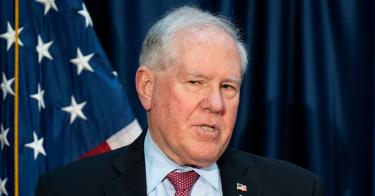Air Force Secretary Frank Kendall is reportedly having second thoughts about his decision to kill a revolutionary, if costly, new engine for the F-35A, and well he should. Even the promised new version of the current F135 engine won’t be able to meet the cooling, thrust, and electrical requirements of the jet’s imminent Block 4 upgrade.
But another aspect of the proposed new engine has received too little attention: how much less fuel it would burn.
The U.S. Air Force is a leading fuel consumer and carbon emitter. Every year its fighters, bombers, tankers, and ISR aircraft rack up more than a million hours of flight time. It would be a real boon if we could reduce fuel consumption without cutting the flying hours that deliver the capabilities and readiness our nation requires.
Fourth-generation fighter engines are powerful but ravenous consumers of fuel. At cruising altitude, a combat-configured F-15EX will burn around 1,800 gallons an hour. A conflict with China might mean sending a typical combat package of 18 fighters from Guam to Taiwan, 1,750 miles each way. During that eight-hour trip, those F-15EXs would burn a total of 285,000 gallons of fuel. They’d also need the services of at least 15 KC-46 tankers to get them there and back. KC-46s burn about 1,720 gallons an hour, which would bring the mission’s total fuel consumption to roughly 491,000 gallons.
>>> 9 Reasons Why the F-35 Needs a New Engine
The numbers for F-35s are better, but still significant. Flying that same mission, 18 F-35s would consume 129,000 gallons and need nine KC-46s for the round trip, bringing the total fuel required to 253,000 gallons.
But what if a new engine came along that could increase the F-35A’s fuel efficiency by 25 percent, increasing its range by 30 percent? Funny you should ask.
Several years ago, the Air Force commissioned a test program for a new fighter engine that could operate like an airline engine when cruising at medium altitude, then “adapt” rapidly into a high-thrust turbine engine when it needed to meet classic fighter demands. Dubbed the Adaptive Engine Transition Program, or AETP, the program funded prototypes by Pratt and Whitney and General Electric. Two of the program’s goals were to increase engine thrust by 10 percent and increase fuel efficiency by 25 percent over the jet’s current F135 engine.
General Electric’s X100 prototype completed testing a few months back, meeting every established goal. Pratt and Whitney has yet to wrap testing of its X101 prototype, but the company has built every F-35 engine ever fielded. The performance data Pratt has compiled over that period should give it a huge advantage, and it is not hard to imagine that the X101 will be even more powerful and efficient than GE’s offering.
If the prototypes merely meet the AETP goals, they will reduce the stealth fighter’s fuel requirements by fully 30 percent. The fuel required for those 18 F-35s to execute their mission would plunge to 90,300 gallons.
The number of KC-46s would also decrease, from nine to six, cutting the mission’s total fuel requirement to just 173,000 gallons. That’s just one-third of the amount needed by the F-15EXs.
At a price of just under $4 a gallon, taxpayers would save $315,000 in that one mission. And they would also save on each of the thousands of F-35 flights every year.
>>> New Adaptive Engine Needed to Preserve Dominant Qualities of the F-35 Joint Strike Fighter
Other savings would accrue as well. Reducing the need for tankers would ease the burden on the Air Refueling fleet’s crews and airframes, extending the life of the latter by 30 percent. Fewer ships would be required to refuel main operating bases and forward operating locations. And the new engine would reduce carbon emissions by some 30 percent.
Meanwhile, the engine upgrade that Secretary Kendall chose over the AETP does not promise such radical changes. By Pratt’s untested estimates, the upgraded F135 will offer a 7 percent increase in range—less than a quarter of what has been demonstrated by AETP. Their estimates for increased thrust, cooling, and electrical power are also all well below those demonstrated by the adaptive engine.
The far-reaching benefits of an AETP engine could unite taxpayers, the Defense Department, industry and environmental groups in celebrating what American know-how can accomplish. More importantly, an adaptive engine would give F-35A pilots the range, acceleration, electrical power and component cooling they would need to dominate the skies in a fight with China. With those facts in mind, Congress and the Pentagon should put their support behind fielding the AETP in the F-35 as rapidly as possible.
This piece originally appeared in Defense One



